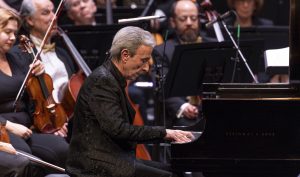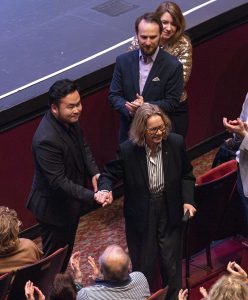
By Márcio Bezerra
The Palm Beach Symphony continued its 50th anniversary celebration Feb. 5 with a satisfying concert at the Kravis Center for the Performing Arts.
Under the music direction of the competent Gerald Schwarz, the local ensemble has bloomed into a serious musical organization and its increasingly audacious programming is proof of that.
On Monday, the main dish served was the orchestral showpiece Scheherazade, by Nicolai Rimsky-Korsakov.A masterful symphonic suite, the work represents the new direction music was taking at the end of the Romantic period. Increasingly, composers were freeing themselves of the restraints of motivic development, relying more and more on timbral effects and exotic extra-musical programs to generate their musical narratives.
A fantastic orchestrator, Rimsky-Korsakov was thus a pioneer of a revolution that would not only give us Claude Debussy, but also continue to inform musical minds all the way to Philip Glass, in recent times.
Schwarz tackled the piece with the confidence of an experienced musician. Although his tempi were on the brisk side, he was able to deliver clarity and balance from all sections. The brass was a highlight; forceful and exciting, but never blaring. Another section worth mentioning was the cellos, which sounded particularly lush. Finally, one cannot fail to mention Concertmaster Evija Ozolins, whose many solos were performed with sonorous sensitivity.

The first part of the program consisted of another in a series of world premieres commissioned by the orchestra. This one was by the award-winning composer Ellen Taaffe Zwilich. Her Orchestral Excursions were a set of five short pieces inspired by architectural landmarks. Written in a very communicative style, the accessible numbers were performed with laudable attention to detail by Schwarz and his band.
The orchestra was joined by pianist Santiago Rodriguez for Edvard Grieg’s Piano Concerto (in A minor, Op. 16). Rodriguez, a Cliburn silver medalist who spent six years of his childhood living in an orphanage as a refug m the Cuban Revolution, is also a distinguished pedagogue, currently teaching at the University of Miami.
He gave the ever-popular concerto a delicate reading, favoring a nuanced approach to its many tuneful themes. His first cadenza was particularly impressive, as it sounded like an improvisation. The result was a standing ovation by the audience, followed by two encores.
Hopefully, the Palm Beach Symphony will continue encoring for another 50 years. Our musical life is undoubtedly richer because of it.